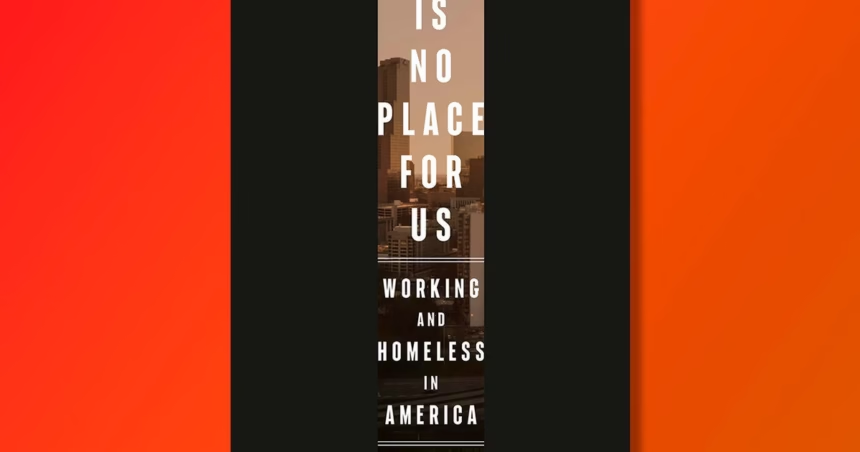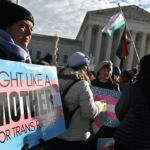Crown
We may receive an affiliate commission from anything you buy from this article.
Journalist Brian Goldstone, who has written for The New York Times, Harper’s Magazine, The New Republic and others, spent about six years examining why so many people who work full-time jobs with low wages are homeless. His new book, “There is No Place for Us” (Crown), explores the challenges faced by millions of the working poor.
In the excerpt below, Celeste (a pseudonym given by Goldstone) describes the bureaucracy she must endure when trying to obtain housing in Atlanta.
Don’t miss Ted Koppel’s interviews with Brian Goldstone and Celeste on “CBS Sunday Morning” November 16!
“There Is No Place For Us” by Brian Goldstone
Prefer to listen? Audible has a 30-day free trial available right now.
When Celeste parked her vehicle down the street from Gateway at 6:00 a.m., a long line was snaking down the sidewalk outside of the building. She’d been told that since homeless assessments were conducted on a first-come, first-served basis, people often began lining up in the middle of the night. Still, she was surprised to find such a large crowd already gathered. The doors wouldn’t be opening for another two hours. Celeste joined the queue, stepping gingerly around handcarts and baby strollers and small clusters of men and women wrapped in blankets, their belongings stacked beside them on the concrete. Having forced herself to eat a lukewarm Cup Noodles for breakfast, she felt woozy — and a little frightened too. A noticeably unwell man was cursing loudly and harassing another person nearby. She considered leaving but decided to stick it out, clutching a manila folder filled with documents while trying to avoid making eye contact with those around her. Six weeks earlier, when Celeste started her cancer treatment, any notion of securing long-term housing on her own had quickly vanished — and with it her resistance to seeking outside assistance. A fear of getting trapped indefinitely at Efficiency now outweighed the embarrassment of pleading for help; pride and dignity were luxuries she could no longer afford. And so, one morning during a work break, she’d gone out to her Durango and fished out the Homeless Resource List given to her by the social worker at Micah’s school. Some phone numbers on the list were disconnected; others prompted her to leave a voicemail. But she was able to get through to a few service providers, and each of them, after Celeste described what she was looking for — help finding a landlord who would rent to her despite the eviction, and maybe some financial support to cover a security deposit — told her the same thing: To receive such aid, she’d first need to undergo an assessment through Gateway’s “coordinated entry” system. And it had to be done in person.
Celeste told Mason’s mom, Christina, her neighbor a couple of doors down, that she was planning on going to Gateway soon. “Good luck with that,” the mother of six scoffed. Her own trek out to Gateway had been fruitless. Celeste thought: Yeah, well, you’re not me. If anyone could navigate this system, it was her. She wasn’t going to be undone by a little paperwork.
It was almost nine-thirty when she finally entered the building. The interior was spacious and clean, if not quite welcoming. An airport-style metal detector opened onto an intake counter, a security guard station, and a few dozen chairs, occupied by people dozing or staring ahead or attempting to console their crying baby while waiting for their name to be called. In a corner of the lobby, alongside a clinic operated by Mercy Care, a community health center, a hallway led to public showers and a clothing bank; in the opposite corner, there was a large room that, on the coldest nights of winter, was used as a warming center for kids and their mothers. (Since 2013, Gateway’s overnight facilities had been designated exclusively for men, but women with children were permitted to sleep in this glass-enclosed space — with no furnishings, no privacy — whenever outside temperatures fell below freezing.) Celeste checked in at the counter, located an unoccupied chair, and waited another hour and a half to be seen.
A petite caseworker conducted Celeste’s assessment in a bare, windowless office. As the woman settled in behind a computer, Celeste placed a stack of documents on her desk — hotel receipts, a police report from the arson, paystubs — and then launched into the story of how she and her kids had ended up without a home, which she’d been rehearsing in her head all morning. Adept at code-switching, she spoke in a clipped, professional manner — what she thought of as her “talking to white people voice.” The caseworker politely stopped her. In order to determine how best to assist her, she said, it was important that she first ask Celeste a series of questions. “Oh, of course. No problem,” Celeste replied.
After a scripted preamble in which the woman explained that only “yes,” “no,” or one-word answers were acceptable and that any question could be skipped or refused, the assessment began. How many months had it been since Celeste had lived in permanent stable housing? Had she ever been diagnosed with a behavioral health disorder? What about HIV or AIDS? Since becoming homeless, had she been arrested? Or tried to harm herself in any way? Or been beaten up? How often did she drink or use drugs? Did she ever exchange sex for money? Or share needles with others?
Celeste was perplexed. She wondered how all this was relevant to her situation. At one point, she gravely mentioned the cancer diagnosis; at another, she interjected to insist that she wasn’t lazy, that she had been working nonstop since she was a teenager. The caseworker tapped away at her keyboard. And where was she living now? the woman asked. Celeste told her about the extended-stay.
The assessment was over in a matter of minutes. The caseworker looked up and sighed. The purpose of these questions, she said, was to figure out who most urgently needed help. Based on the answers Celeste provided, it was clear that her vulnerability score, as the woman called it, would be very low — too low to qualify for housing assistance. The score had been calculated using the Vulnerability Index — Service Prioritization Decision Assistance Tool, or the VI-SPDAT. Created in 2013 by OrgCode Consulting, the VI-SPDAT was quickly adopted nationwide, as local communities sought to meet a new federal regulation that made funding for homeless services contingent on the implementation of a standardized intake and assessment process. The stated objective of the VI-SPDAT was to identify homeless individuals who were most at risk of dying or being sent to a jail or hospital, and to parcel out limited resources accordingly. In cities and counties across the United States, this technical-sounding survey had become a key instrument in efforts to address homelessness: a mechanism for determining who would — and would not — be eligible for support.
“But what about the cancer?” Celeste asked, her tone changing. It felt demeaning to have to ask such a question. She had begun to realize that all the things she had been so proud of, such as her work ethic, were making it more, not less, likely that she would leave Gateway empty-handed. “Doesn’t that count for anything?”
“Yes,” the caseworker said, seeming to choose her words carefully. The illness did make Celeste more at risk. The real obstacle, however, was that she and her children did not fit the criteria for “literal homelessness” as set out by HUD. “In order to get housing aid,” she continued, “you have to be considered literally homeless, which means you’re in a shelter or on the street. Unfortunately, other circumstances don’t qualify.”
Celeste’s predicament was increasingly common. The existing support system ignored scores of homeless families who did not fit the government’s definition of “homeless.” Advocacy groups had been fighting to expand the definition, refuting the myth that families with children living in extended-stays and doubled-up arrangements were somehow less vulnerable than other homeless populations; they argued that these conditions could be just as detrimental to a child’s education, mental and physical health, and long-term development. Indeed, the U.S. Department of Education counted as homeless anyone who lacked “a fixed, regular, and adequate nighttime residence” — which explicitly included those in hotels, motels, and living temporarily with others. That year, 2019, the Department of Education reported 35,538 homeless children and youth enrolled in Georgia public schools, an increase of 34 percent from a decade earlier. But the state’s HUD-administered total — not only for children and youth but Georgia’s entire homeless population — was 10,433. Politicians cited the smaller number when discussing homelessness in the state, claiming it was on the decline. This figure also helped determine the amount of money allocated to homeless services the following year. Meanwhile, the parents of those 35,538 students were caught between two parallel definitions. At their child’s school, they were considered homeless. At places like Gateway, they were not.
“So let me get this straight,” Celeste said. “If I want y’all’s help getting a home for me and my kids, I need to be considered — what did you call it — literally homeless?”
“Yes, that’s correct.”
“And to be considered literally homeless, we’ve gotta be in a shelter?”
“That’s right. Or somewhere not meant for human habitation.”
“All right then,” Celeste said. “So how do we get into a shelter?”
The caseworker took a deep breath. “You said your son recently turned fifteen?”
“Yes.”
“I hate to say it, but I don’t know of any family shelters that allow boys over the age of thirteen. Usually older boys have to go to a men’s shelter.”
“No way,” Celeste said. “Absolutely not. I’m not going to let my family be separated.”
“I wish I had more to offer,” the woman said. “I’m sorry.”
When Celeste left the building, the line outside Gateway was just as long as it had been that morning.
From the book “There Is No Place For Us: Working and Homeless in America” by Brian Goldstone. Copyright © 2025 by Brian Goldstone. Published in the United States by Crown, an imprint of the Crown Publishing Group, a division of Penguin Random House, LLC.
Get the book here:
“There Is No Place For Us” by Brian Goldstone
Buy locally from Bookshop.org
For more info:















